Report on Assessment and Intervention in School Psychology Services
VerifiedAdded on 2022/02/04
|8
|2699
|40
Report
AI Summary
This report provides a comprehensive overview of assessment and intervention within school psychology services, emphasizing the critical roles of measurement and testing. It differentiates between assessment, testing, and measurement, highlighting the various types of assessment such as summative, formative, evaluative, diagnostic, norm-referenced, and performance-based assessments, along with associated tools and techniques like anecdotal records, observations, and rating scales. The report also addresses the limitations of assessment, focusing on reliability, validity, and the absence of bias. Furthermore, it explores different types of tests, including intelligence, personality, attitude, achievement, aptitude, neuropsychological, and vocational tests, and underscores their importance in producing objective measures, enabling normative comparisons, and predicting learning outcomes. The document also discusses the evaluation of child learning outcomes in reading, writing and mathematics and the need to improve functioning across a variety of contexts.
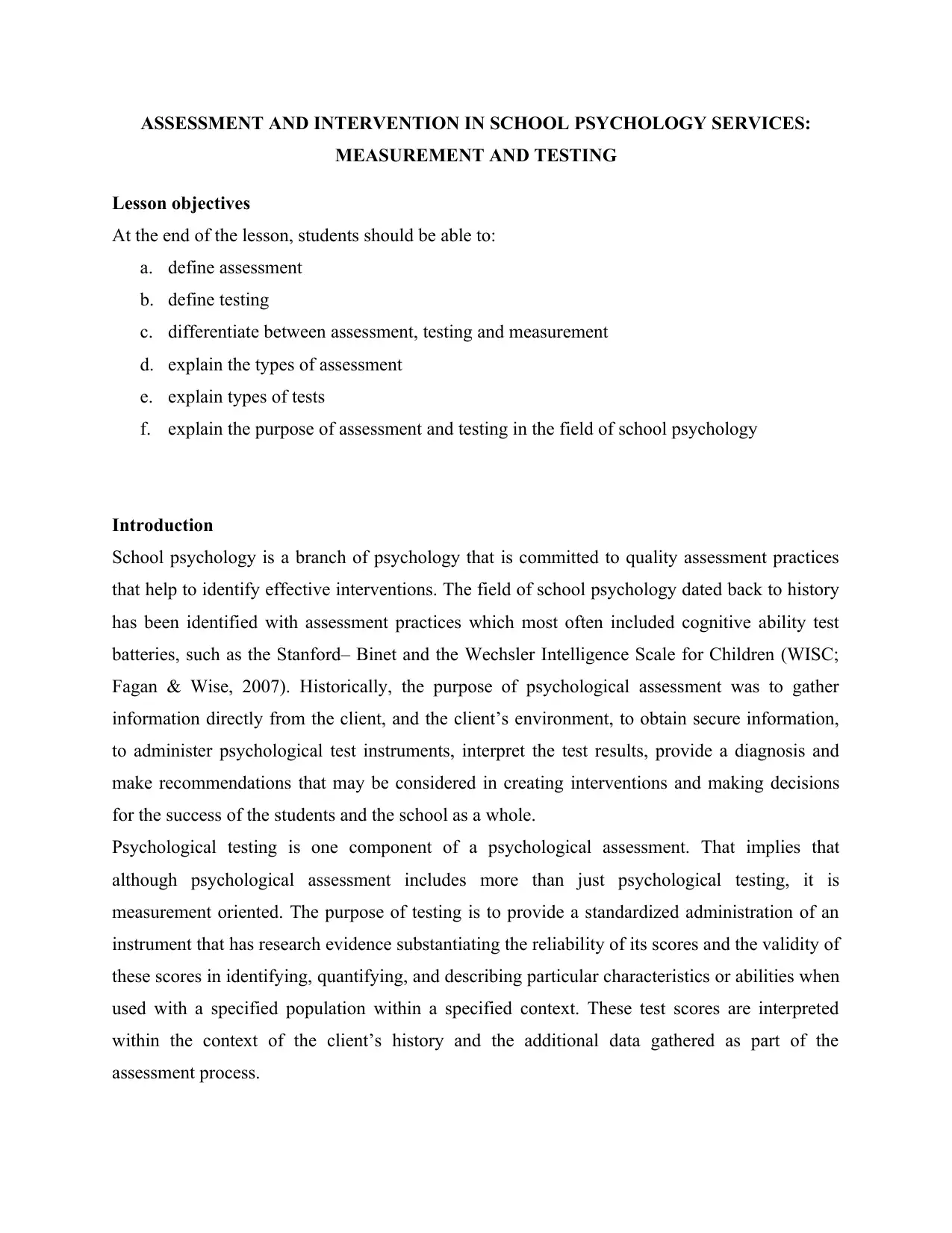
ASSESSMENT AND INTERVENTION IN SCHOOL PSYCHOLOGY SERVICES:
MEASUREMENT AND TESTING
Lesson objectives
At the end of the lesson, students should be able to:
a. define assessment
b. define testing
c. differentiate between assessment, testing and measurement
d. explain the types of assessment
e. explain types of tests
f. explain the purpose of assessment and testing in the field of school psychology
Introduction
School psychology is a branch of psychology that is committed to quality assessment practices
that help to identify effective interventions. The field of school psychology dated back to history
has been identified with assessment practices which most often included cognitive ability test
batteries, such as the Stanford– Binet and the Wechsler Intelligence Scale for Children (WISC;
Fagan & Wise, 2007). Historically, the purpose of psychological assessment was to gather
information directly from the client, and the client’s environment, to obtain secure information,
to administer psychological test instruments, interpret the test results, provide a diagnosis and
make recommendations that may be considered in creating interventions and making decisions
for the success of the students and the school as a whole.
Psychological testing is one component of a psychological assessment. That implies that
although psychological assessment includes more than just psychological testing, it is
measurement oriented. The purpose of testing is to provide a standardized administration of an
instrument that has research evidence substantiating the reliability of its scores and the validity of
these scores in identifying, quantifying, and describing particular characteristics or abilities when
used with a specified population within a specified context. These test scores are interpreted
within the context of the client’s history and the additional data gathered as part of the
assessment process.
MEASUREMENT AND TESTING
Lesson objectives
At the end of the lesson, students should be able to:
a. define assessment
b. define testing
c. differentiate between assessment, testing and measurement
d. explain the types of assessment
e. explain types of tests
f. explain the purpose of assessment and testing in the field of school psychology
Introduction
School psychology is a branch of psychology that is committed to quality assessment practices
that help to identify effective interventions. The field of school psychology dated back to history
has been identified with assessment practices which most often included cognitive ability test
batteries, such as the Stanford– Binet and the Wechsler Intelligence Scale for Children (WISC;
Fagan & Wise, 2007). Historically, the purpose of psychological assessment was to gather
information directly from the client, and the client’s environment, to obtain secure information,
to administer psychological test instruments, interpret the test results, provide a diagnosis and
make recommendations that may be considered in creating interventions and making decisions
for the success of the students and the school as a whole.
Psychological testing is one component of a psychological assessment. That implies that
although psychological assessment includes more than just psychological testing, it is
measurement oriented. The purpose of testing is to provide a standardized administration of an
instrument that has research evidence substantiating the reliability of its scores and the validity of
these scores in identifying, quantifying, and describing particular characteristics or abilities when
used with a specified population within a specified context. These test scores are interpreted
within the context of the client’s history and the additional data gathered as part of the
assessment process.
Paraphrase This Document
Need a fresh take? Get an instant paraphrase of this document with our AI Paraphraser

In contrast, the purpose of a psychological assessment is to answer particular questions related to
an individual’s intellectual, psychological, emotional–behavioral, or psychosocial functioning, or
some combination of these domains. A psychological assessment can include numerous
components such as norm-referenced psychological tests, informal tests and surveys, interview
information, school or medical records, medical evaluation and observational data. A
psychologist determines what information to use based on the specific questions being asked and
the data collected. For example, assessments can be used to determine if a student has a learning
disorder, or has a traumatic brain injury. They can also be used to determine what aspects a
student would be good or how well they could work with a team.
Assessments are usually created and selected by teachers because they are constantly in the
process of teaching and evaluation. Classroom assessments can take many different forms—unit
tests, essays, portfolios, group projects, performances, oral presentations. Classroom assessment
and standardized testing, can be viewed with an emphasis on the former, because teachers are
responsible for classroom assessments.
Difference between Measurement and Assessment.
Measurement and Assessment Measurement is quantitative—the description of an event or
characteristic using numbers. Measurement tells how much, how often, or how well by providing
scores, ranks, or ratings. For example, Instead of saying, “Bisi lacks adequate understanding of
mathematical formula, ” a teacher might say, “Bisi solved only 2 of the 15 problems correctly in
her mathematics homework.” Measurement also allows a teacher to compare one student’s
performance on a particular task with either a specific standard or the performances of other
students on the same task.
Not all the decisions made by teachers involve measurement. Some decisions are based on
information that is difficult to express numerically: student preferences, discussions with
families, previous experiences, even intuition. But measurement does play a large role in many
classroom decisions, and, when properly done, it can provide unbiased data for decision making.
Increasingly, measurement specialists are using the term assessment to describe the process of
gathering information about students’ learning.
Assessment is broader than testing and measurement because it includes all kinds of ways to
sample and observe students’ skills, knowledge, and abilities (R. L. Linn & Miller, 2005).
Assessments can be formal, such as unit tests, or informal, such as observing who emerges as a
an individual’s intellectual, psychological, emotional–behavioral, or psychosocial functioning, or
some combination of these domains. A psychological assessment can include numerous
components such as norm-referenced psychological tests, informal tests and surveys, interview
information, school or medical records, medical evaluation and observational data. A
psychologist determines what information to use based on the specific questions being asked and
the data collected. For example, assessments can be used to determine if a student has a learning
disorder, or has a traumatic brain injury. They can also be used to determine what aspects a
student would be good or how well they could work with a team.
Assessments are usually created and selected by teachers because they are constantly in the
process of teaching and evaluation. Classroom assessments can take many different forms—unit
tests, essays, portfolios, group projects, performances, oral presentations. Classroom assessment
and standardized testing, can be viewed with an emphasis on the former, because teachers are
responsible for classroom assessments.
Difference between Measurement and Assessment.
Measurement and Assessment Measurement is quantitative—the description of an event or
characteristic using numbers. Measurement tells how much, how often, or how well by providing
scores, ranks, or ratings. For example, Instead of saying, “Bisi lacks adequate understanding of
mathematical formula, ” a teacher might say, “Bisi solved only 2 of the 15 problems correctly in
her mathematics homework.” Measurement also allows a teacher to compare one student’s
performance on a particular task with either a specific standard or the performances of other
students on the same task.
Not all the decisions made by teachers involve measurement. Some decisions are based on
information that is difficult to express numerically: student preferences, discussions with
families, previous experiences, even intuition. But measurement does play a large role in many
classroom decisions, and, when properly done, it can provide unbiased data for decision making.
Increasingly, measurement specialists are using the term assessment to describe the process of
gathering information about students’ learning.
Assessment is broader than testing and measurement because it includes all kinds of ways to
sample and observe students’ skills, knowledge, and abilities (R. L. Linn & Miller, 2005).
Assessments can be formal, such as unit tests, or informal, such as observing who emerges as a
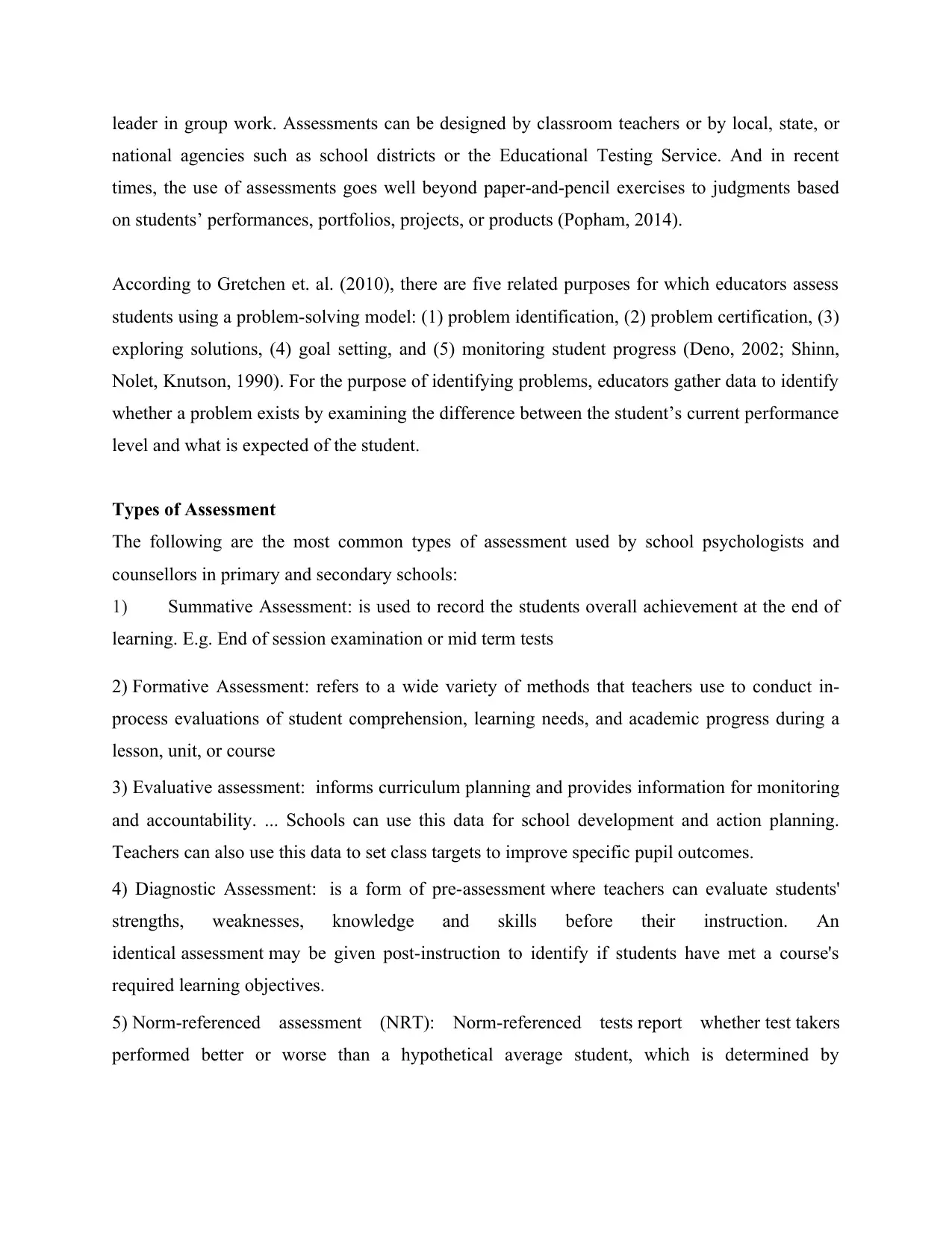
leader in group work. Assessments can be designed by classroom teachers or by local, state, or
national agencies such as school districts or the Educational Testing Service. And in recent
times, the use of assessments goes well beyond paper-and-pencil exercises to judgments based
on students’ performances, portfolios, projects, or products (Popham, 2014).
According to Gretchen et. al. (2010), there are five related purposes for which educators assess
students using a problem-solving model: (1) problem identification, (2) problem certification, (3)
exploring solutions, (4) goal setting, and (5) monitoring student progress (Deno, 2002; Shinn,
Nolet, Knutson, 1990). For the purpose of identifying problems, educators gather data to identify
whether a problem exists by examining the difference between the student’s current performance
level and what is expected of the student.
Types of Assessment
The following are the most common types of assessment used by school psychologists and
counsellors in primary and secondary schools:
1) Summative Assessment: is used to record the students overall achievement at the end of
learning. E.g. End of session examination or mid term tests
2) Formative Assessment: refers to a wide variety of methods that teachers use to conduct in-
process evaluations of student comprehension, learning needs, and academic progress during a
lesson, unit, or course
3) Evaluative assessment: informs curriculum planning and provides information for monitoring
and accountability. ... Schools can use this data for school development and action planning.
Teachers can also use this data to set class targets to improve specific pupil outcomes.
4) Diagnostic Assessment: is a form of pre-assessment where teachers can evaluate students'
strengths, weaknesses, knowledge and skills before their instruction. An
identical assessment may be given post-instruction to identify if students have met a course's
required learning objectives.
5) Norm-referenced assessment (NRT): Norm-referenced tests report whether test takers
performed better or worse than a hypothetical average student, which is determined by
national agencies such as school districts or the Educational Testing Service. And in recent
times, the use of assessments goes well beyond paper-and-pencil exercises to judgments based
on students’ performances, portfolios, projects, or products (Popham, 2014).
According to Gretchen et. al. (2010), there are five related purposes for which educators assess
students using a problem-solving model: (1) problem identification, (2) problem certification, (3)
exploring solutions, (4) goal setting, and (5) monitoring student progress (Deno, 2002; Shinn,
Nolet, Knutson, 1990). For the purpose of identifying problems, educators gather data to identify
whether a problem exists by examining the difference between the student’s current performance
level and what is expected of the student.
Types of Assessment
The following are the most common types of assessment used by school psychologists and
counsellors in primary and secondary schools:
1) Summative Assessment: is used to record the students overall achievement at the end of
learning. E.g. End of session examination or mid term tests
2) Formative Assessment: refers to a wide variety of methods that teachers use to conduct in-
process evaluations of student comprehension, learning needs, and academic progress during a
lesson, unit, or course
3) Evaluative assessment: informs curriculum planning and provides information for monitoring
and accountability. ... Schools can use this data for school development and action planning.
Teachers can also use this data to set class targets to improve specific pupil outcomes.
4) Diagnostic Assessment: is a form of pre-assessment where teachers can evaluate students'
strengths, weaknesses, knowledge and skills before their instruction. An
identical assessment may be given post-instruction to identify if students have met a course's
required learning objectives.
5) Norm-referenced assessment (NRT): Norm-referenced tests report whether test takers
performed better or worse than a hypothetical average student, which is determined by
⊘ This is a preview!⊘
Do you want full access?
Subscribe today to unlock all pages.

Trusted by 1+ million students worldwide
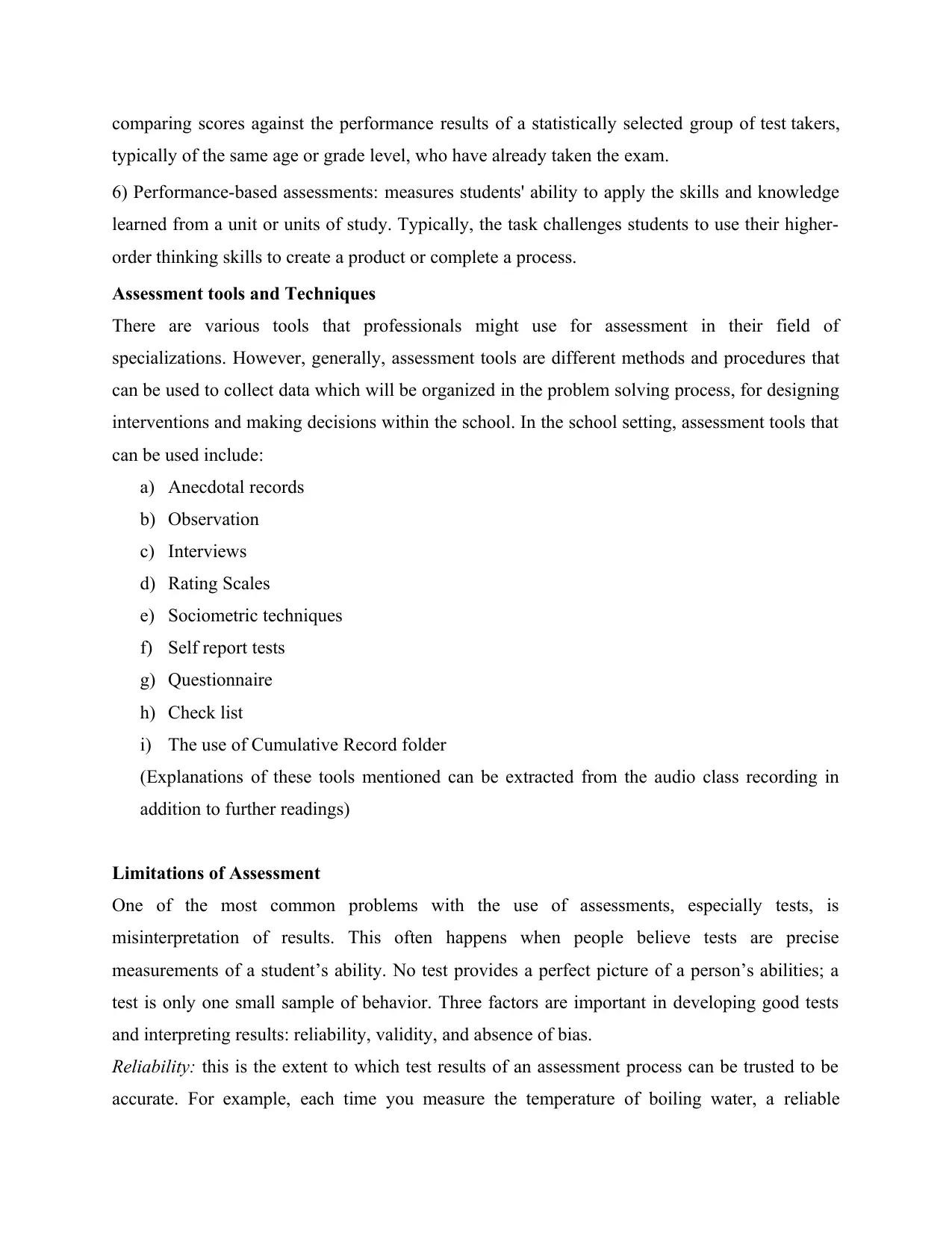
comparing scores against the performance results of a statistically selected group of test takers,
typically of the same age or grade level, who have already taken the exam.
6) Performance-based assessments: measures students' ability to apply the skills and knowledge
learned from a unit or units of study. Typically, the task challenges students to use their higher-
order thinking skills to create a product or complete a process.
Assessment tools and Techniques
There are various tools that professionals might use for assessment in their field of
specializations. However, generally, assessment tools are different methods and procedures that
can be used to collect data which will be organized in the problem solving process, for designing
interventions and making decisions within the school. In the school setting, assessment tools that
can be used include:
a) Anecdotal records
b) Observation
c) Interviews
d) Rating Scales
e) Sociometric techniques
f) Self report tests
g) Questionnaire
h) Check list
i) The use of Cumulative Record folder
(Explanations of these tools mentioned can be extracted from the audio class recording in
addition to further readings)
Limitations of Assessment
One of the most common problems with the use of assessments, especially tests, is
misinterpretation of results. This often happens when people believe tests are precise
measurements of a student’s ability. No test provides a perfect picture of a person’s abilities; a
test is only one small sample of behavior. Three factors are important in developing good tests
and interpreting results: reliability, validity, and absence of bias.
Reliability: this is the extent to which test results of an assessment process can be trusted to be
accurate. For example, each time you measure the temperature of boiling water, a reliable
typically of the same age or grade level, who have already taken the exam.
6) Performance-based assessments: measures students' ability to apply the skills and knowledge
learned from a unit or units of study. Typically, the task challenges students to use their higher-
order thinking skills to create a product or complete a process.
Assessment tools and Techniques
There are various tools that professionals might use for assessment in their field of
specializations. However, generally, assessment tools are different methods and procedures that
can be used to collect data which will be organized in the problem solving process, for designing
interventions and making decisions within the school. In the school setting, assessment tools that
can be used include:
a) Anecdotal records
b) Observation
c) Interviews
d) Rating Scales
e) Sociometric techniques
f) Self report tests
g) Questionnaire
h) Check list
i) The use of Cumulative Record folder
(Explanations of these tools mentioned can be extracted from the audio class recording in
addition to further readings)
Limitations of Assessment
One of the most common problems with the use of assessments, especially tests, is
misinterpretation of results. This often happens when people believe tests are precise
measurements of a student’s ability. No test provides a perfect picture of a person’s abilities; a
test is only one small sample of behavior. Three factors are important in developing good tests
and interpreting results: reliability, validity, and absence of bias.
Reliability: this is the extent to which test results of an assessment process can be trusted to be
accurate. For example, each time you measure the temperature of boiling water, a reliable
Paraphrase This Document
Need a fresh take? Get an instant paraphrase of this document with our AI Paraphraser
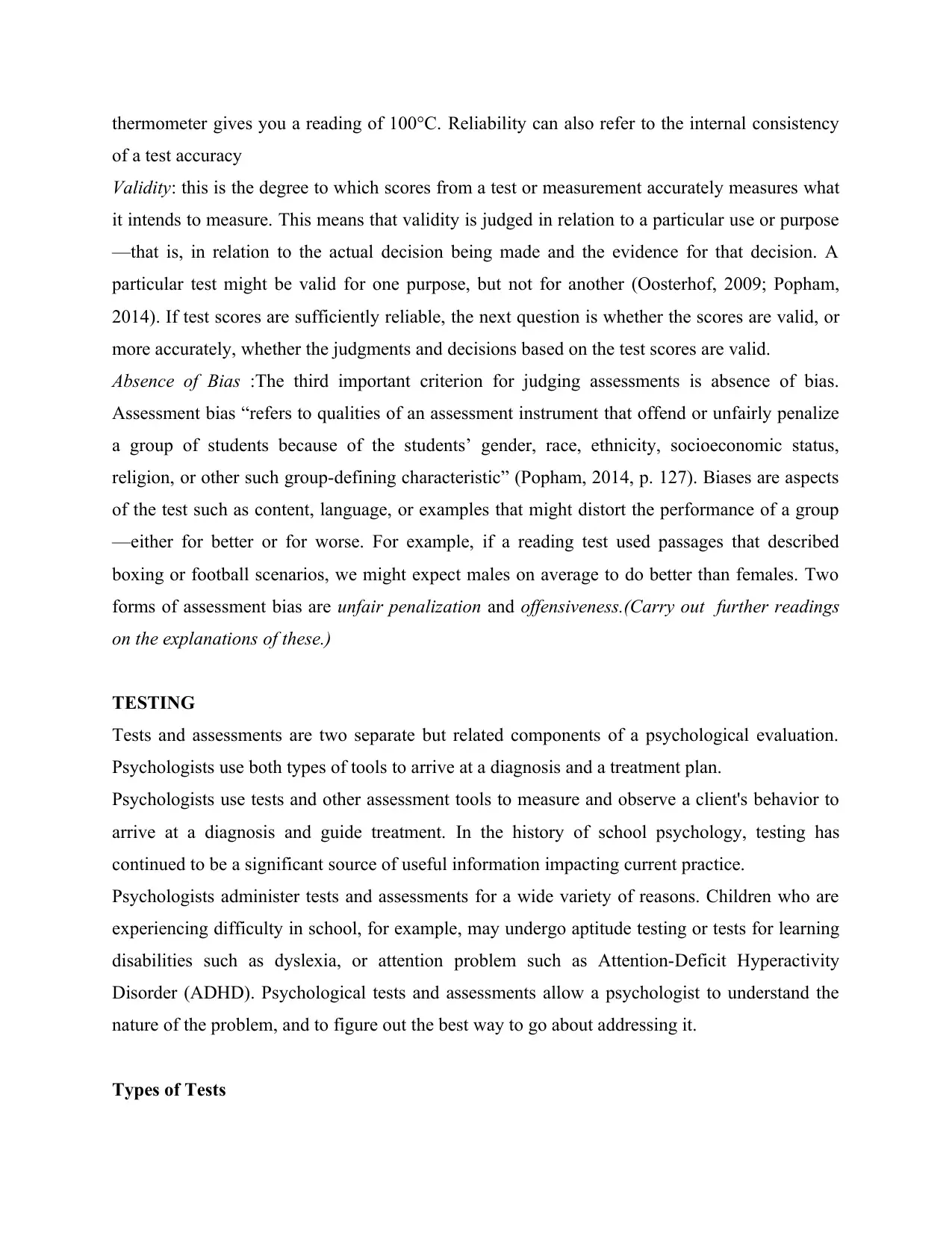
thermometer gives you a reading of 100°C. Reliability can also refer to the internal consistency
of a test accuracy
Validity: this is the degree to which scores from a test or measurement accurately measures what
it intends to measure. This means that validity is judged in relation to a particular use or purpose
—that is, in relation to the actual decision being made and the evidence for that decision. A
particular test might be valid for one purpose, but not for another (Oosterhof, 2009; Popham,
2014). If test scores are sufficiently reliable, the next question is whether the scores are valid, or
more accurately, whether the judgments and decisions based on the test scores are valid.
Absence of Bias :The third important criterion for judging assessments is absence of bias.
Assessment bias “refers to qualities of an assessment instrument that offend or unfairly penalize
a group of students because of the students’ gender, race, ethnicity, socioeconomic status,
religion, or other such group-defining characteristic” (Popham, 2014, p. 127). Biases are aspects
of the test such as content, language, or examples that might distort the performance of a group
—either for better or for worse. For example, if a reading test used passages that described
boxing or football scenarios, we might expect males on average to do better than females. Two
forms of assessment bias are unfair penalization and offensiveness.(Carry out further readings
on the explanations of these.)
TESTING
Tests and assessments are two separate but related components of a psychological evaluation.
Psychologists use both types of tools to arrive at a diagnosis and a treatment plan.
Psychologists use tests and other assessment tools to measure and observe a client's behavior to
arrive at a diagnosis and guide treatment. In the history of school psychology, testing has
continued to be a significant source of useful information impacting current practice.
Psychologists administer tests and assessments for a wide variety of reasons. Children who are
experiencing difficulty in school, for example, may undergo aptitude testing or tests for learning
disabilities such as dyslexia, or attention problem such as Attention-Deficit Hyperactivity
Disorder (ADHD). Psychological tests and assessments allow a psychologist to understand the
nature of the problem, and to figure out the best way to go about addressing it.
Types of Tests
of a test accuracy
Validity: this is the degree to which scores from a test or measurement accurately measures what
it intends to measure. This means that validity is judged in relation to a particular use or purpose
—that is, in relation to the actual decision being made and the evidence for that decision. A
particular test might be valid for one purpose, but not for another (Oosterhof, 2009; Popham,
2014). If test scores are sufficiently reliable, the next question is whether the scores are valid, or
more accurately, whether the judgments and decisions based on the test scores are valid.
Absence of Bias :The third important criterion for judging assessments is absence of bias.
Assessment bias “refers to qualities of an assessment instrument that offend or unfairly penalize
a group of students because of the students’ gender, race, ethnicity, socioeconomic status,
religion, or other such group-defining characteristic” (Popham, 2014, p. 127). Biases are aspects
of the test such as content, language, or examples that might distort the performance of a group
—either for better or for worse. For example, if a reading test used passages that described
boxing or football scenarios, we might expect males on average to do better than females. Two
forms of assessment bias are unfair penalization and offensiveness.(Carry out further readings
on the explanations of these.)
TESTING
Tests and assessments are two separate but related components of a psychological evaluation.
Psychologists use both types of tools to arrive at a diagnosis and a treatment plan.
Psychologists use tests and other assessment tools to measure and observe a client's behavior to
arrive at a diagnosis and guide treatment. In the history of school psychology, testing has
continued to be a significant source of useful information impacting current practice.
Psychologists administer tests and assessments for a wide variety of reasons. Children who are
experiencing difficulty in school, for example, may undergo aptitude testing or tests for learning
disabilities such as dyslexia, or attention problem such as Attention-Deficit Hyperactivity
Disorder (ADHD). Psychological tests and assessments allow a psychologist to understand the
nature of the problem, and to figure out the best way to go about addressing it.
Types of Tests
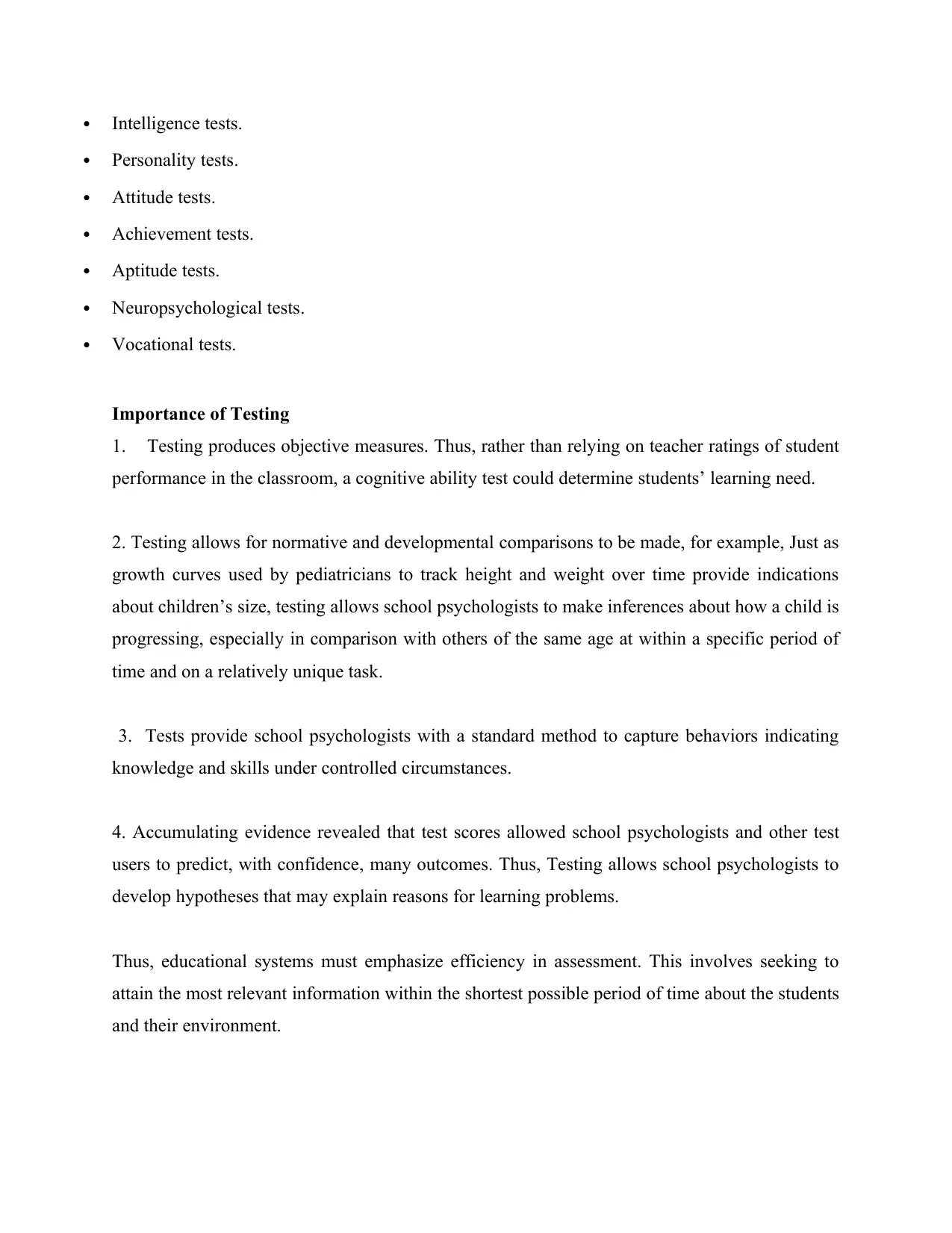
Intelligence tests.
Personality tests.
Attitude tests.
Achievement tests.
Aptitude tests.
Neuropsychological tests.
Vocational tests.
Importance of Testing
1. Testing produces objective measures. Thus, rather than relying on teacher ratings of student
performance in the classroom, a cognitive ability test could determine students’ learning need.
2. Testing allows for normative and developmental comparisons to be made, for example, Just as
growth curves used by pediatricians to track height and weight over time provide indications
about children’s size, testing allows school psychologists to make inferences about how a child is
progressing, especially in comparison with others of the same age at within a specific period of
time and on a relatively unique task.
3. Tests provide school psychologists with a standard method to capture behaviors indicating
knowledge and skills under controlled circumstances.
4. Accumulating evidence revealed that test scores allowed school psychologists and other test
users to predict, with confidence, many outcomes. Thus, Testing allows school psychologists to
develop hypotheses that may explain reasons for learning problems.
Thus, educational systems must emphasize efficiency in assessment. This involves seeking to
attain the most relevant information within the shortest possible period of time about the students
and their environment.
Personality tests.
Attitude tests.
Achievement tests.
Aptitude tests.
Neuropsychological tests.
Vocational tests.
Importance of Testing
1. Testing produces objective measures. Thus, rather than relying on teacher ratings of student
performance in the classroom, a cognitive ability test could determine students’ learning need.
2. Testing allows for normative and developmental comparisons to be made, for example, Just as
growth curves used by pediatricians to track height and weight over time provide indications
about children’s size, testing allows school psychologists to make inferences about how a child is
progressing, especially in comparison with others of the same age at within a specific period of
time and on a relatively unique task.
3. Tests provide school psychologists with a standard method to capture behaviors indicating
knowledge and skills under controlled circumstances.
4. Accumulating evidence revealed that test scores allowed school psychologists and other test
users to predict, with confidence, many outcomes. Thus, Testing allows school psychologists to
develop hypotheses that may explain reasons for learning problems.
Thus, educational systems must emphasize efficiency in assessment. This involves seeking to
attain the most relevant information within the shortest possible period of time about the students
and their environment.
⊘ This is a preview!⊘
Do you want full access?
Subscribe today to unlock all pages.

Trusted by 1+ million students worldwide

Testing Diverse Skills for Child Learning Outcomes (Reading, Writing, Mathematics)
Critical skills are skills that are generative, meaning that if they are mastered child functioning is
improved in a robust way across a variety of contexts.
Although students may gain many important skills throughout their schooling experience (e.g.,
social development, peer relationships, communication, and personal organization skills),
teachers, parents, and students can generally embrace the idea that the primary purpose of
academic instruction is student learning. If instruction is intended to meaningfully accelerate
learning and to help students build an adaptive and useful skill set and knowledge base, then
evaluating the degree to which that goal is being met requires a focus on academic outcomes.
These skills and their expected time of development provide benchmarks against which child
learning can be evaluated to ensure that instruction is advancing child mastery of fundamental
skills and concepts and is doing so at the right pace. Child learning outcomes can be evaluated in
two ways: (1) Static performance can be evaluated relative to established expectations for
performance at that point in the program of instruction, and (2) the learning trajectory can be
evaluated relative to the trajectory that is needed to reach key benchmarks over time or relative
to trajectories of students who are not at risk for poor learning outcomes.
Early reading skills, including the ability to identify and manipulate phonemes (sounds) to
decode words and ultimately to fluently read words and connected text, are essential to deriving
meaning from what is read. The ability to independently comprehend printed material provides
the foundation for students to read for information as schooling progresses and facilitates
learning of content in topical areas such as history or science. In the area of mathematics, a
logical sequence of computational skills can be identified that reflects functional and generative
learning outcomes of early mathematics instruction (e.g., addition, subtraction, and
multiplication facts and procedures). These skills are generative skills because a child’s ability to
fluently handle multiplication with regrouping will be highly related to the child’s ability to
master skills that will be introduced later in the program of instruction, such as converting
fractions or computing percentages. Further, a child’s ability to fluently complete multiplication
problems enhances the child’s ability to benefit from instruction that will take place in
Critical skills are skills that are generative, meaning that if they are mastered child functioning is
improved in a robust way across a variety of contexts.
Although students may gain many important skills throughout their schooling experience (e.g.,
social development, peer relationships, communication, and personal organization skills),
teachers, parents, and students can generally embrace the idea that the primary purpose of
academic instruction is student learning. If instruction is intended to meaningfully accelerate
learning and to help students build an adaptive and useful skill set and knowledge base, then
evaluating the degree to which that goal is being met requires a focus on academic outcomes.
These skills and their expected time of development provide benchmarks against which child
learning can be evaluated to ensure that instruction is advancing child mastery of fundamental
skills and concepts and is doing so at the right pace. Child learning outcomes can be evaluated in
two ways: (1) Static performance can be evaluated relative to established expectations for
performance at that point in the program of instruction, and (2) the learning trajectory can be
evaluated relative to the trajectory that is needed to reach key benchmarks over time or relative
to trajectories of students who are not at risk for poor learning outcomes.
Early reading skills, including the ability to identify and manipulate phonemes (sounds) to
decode words and ultimately to fluently read words and connected text, are essential to deriving
meaning from what is read. The ability to independently comprehend printed material provides
the foundation for students to read for information as schooling progresses and facilitates
learning of content in topical areas such as history or science. In the area of mathematics, a
logical sequence of computational skills can be identified that reflects functional and generative
learning outcomes of early mathematics instruction (e.g., addition, subtraction, and
multiplication facts and procedures). These skills are generative skills because a child’s ability to
fluently handle multiplication with regrouping will be highly related to the child’s ability to
master skills that will be introduced later in the program of instruction, such as converting
fractions or computing percentages. Further, a child’s ability to fluently complete multiplication
problems enhances the child’s ability to benefit from instruction that will take place in
Paraphrase This Document
Need a fresh take? Get an instant paraphrase of this document with our AI Paraphraser
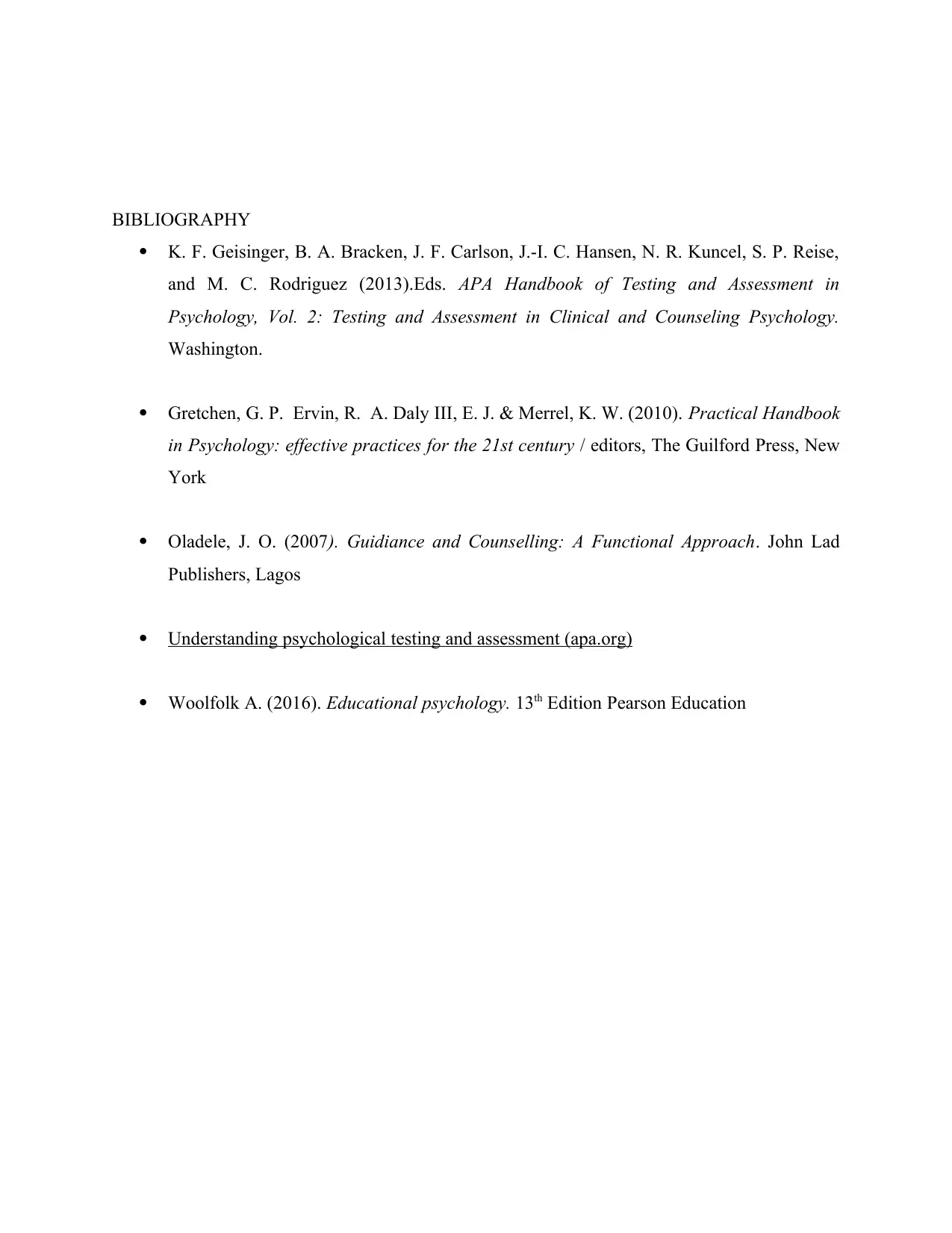
mathematics in the future to establish understanding of mathematical concepts such as factors.
Hence computational skills offer logical targets for evaluating learning outcomes in mathematics
BIBLIOGRAPHY
K. F. Geisinger, B. A. Bracken, J. F. Carlson, J.-I. C. Hansen, N. R. Kuncel, S. P. Reise,
and M. C. Rodriguez (2013).Eds. APA Handbook of Testing and Assessment in
Psychology, Vol. 2: Testing and Assessment in Clinical and Counseling Psychology.
Washington.
Gretchen, G. P. Ervin, R. A. Daly III, E. J. & Merrel, K. W. (2010). Practical Handbook
in Psychology: effective practices for the 21st century / editors, The Guilford Press, New
York
Oladele, J. O. (2007). Guidiance and Counselling: A Functional Approach. John Lad
Publishers, Lagos
Understanding psychological testing and assessment (apa.org)
Woolfolk A. (2016). Educational psychology. 13th Edition Pearson Education
Hence computational skills offer logical targets for evaluating learning outcomes in mathematics
BIBLIOGRAPHY
K. F. Geisinger, B. A. Bracken, J. F. Carlson, J.-I. C. Hansen, N. R. Kuncel, S. P. Reise,
and M. C. Rodriguez (2013).Eds. APA Handbook of Testing and Assessment in
Psychology, Vol. 2: Testing and Assessment in Clinical and Counseling Psychology.
Washington.
Gretchen, G. P. Ervin, R. A. Daly III, E. J. & Merrel, K. W. (2010). Practical Handbook
in Psychology: effective practices for the 21st century / editors, The Guilford Press, New
York
Oladele, J. O. (2007). Guidiance and Counselling: A Functional Approach. John Lad
Publishers, Lagos
Understanding psychological testing and assessment (apa.org)
Woolfolk A. (2016). Educational psychology. 13th Edition Pearson Education
1 out of 8
Related Documents
Your All-in-One AI-Powered Toolkit for Academic Success.
+13062052269
info@desklib.com
Available 24*7 on WhatsApp / Email
![[object Object]](/_next/static/media/star-bottom.7253800d.svg)
Unlock your academic potential
Copyright © 2020–2025 A2Z Services. All Rights Reserved. Developed and managed by ZUCOL.





